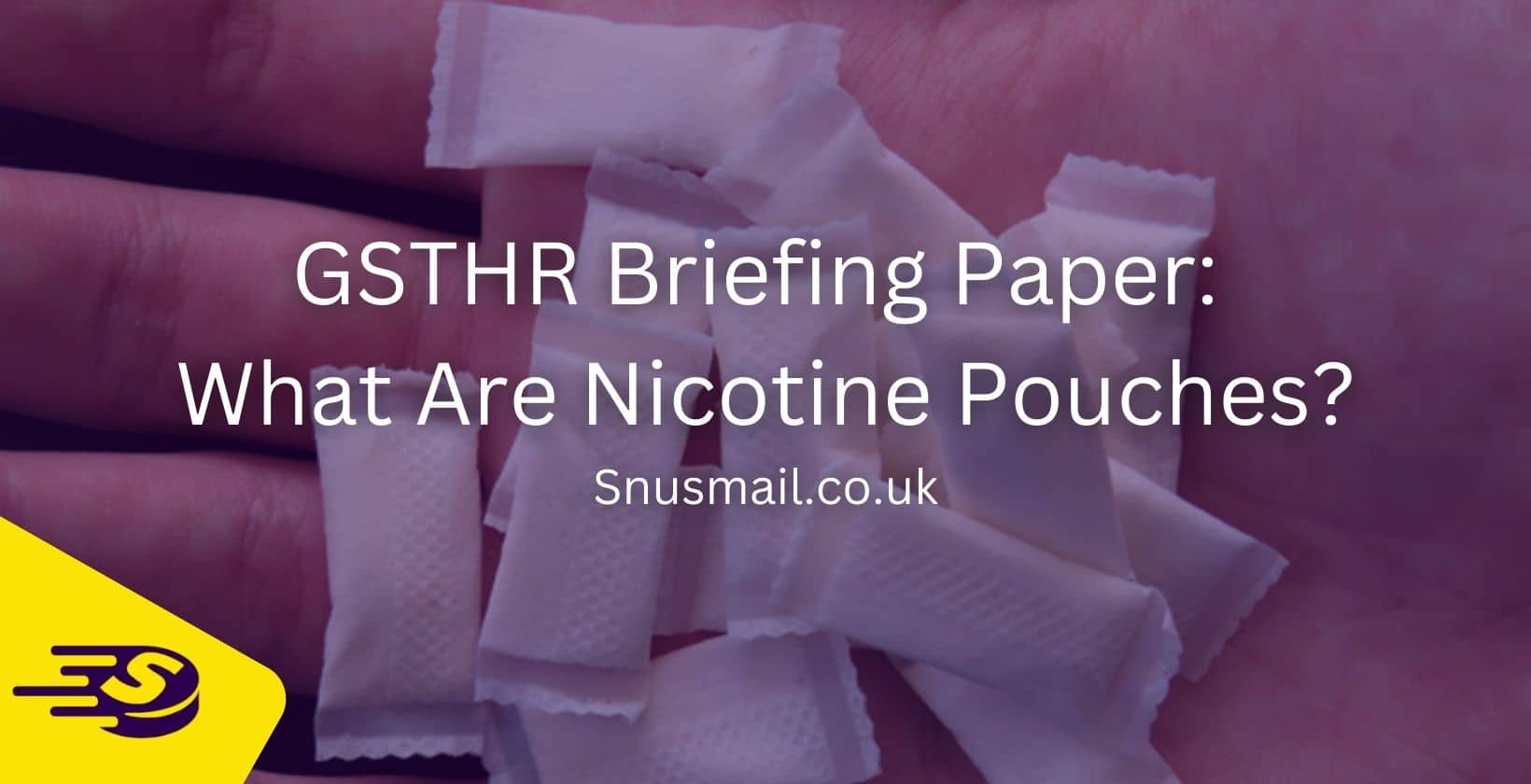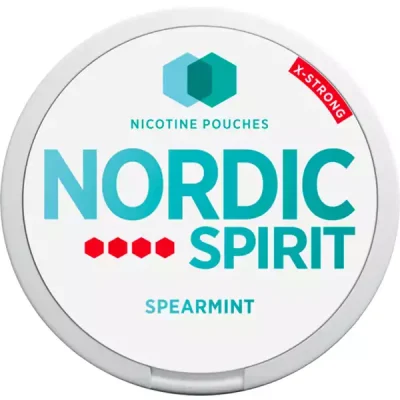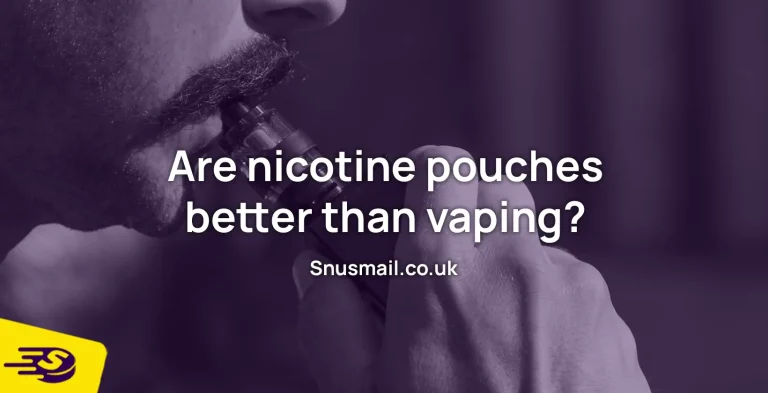GSTHR Briefing Paper – What Are Nicotine Pouches?
Knowledge-Action-Change are an organisation that focuses heavily on harm reduction as a key public health strategy. And this applies to several different specific areas by providing safer forms of less hazardous products or encouraging less risky behaviours.
One of the arms of this organisation is the “Global State of Tobacco Harm Reduction” (GSTHR) which maps the global, national and regional availability and use of safer nicotine products as well as looking at the regulatory responses to these products and the public health potential of tobacco harm reduction. This is really good resource which collates the data regarding smoking, as well as the use of things like E-Cigarettes and most notably Nicotine Pouches.
Recently they published a Paper which briefed the topic solely focusing on Nicotine Pouches. Taking a look at what they are, what they do, and how much they are being used around the globe. And in this article, I’m going to take a deep dive into this briefing paper and see what they have to say on the matter. Let’s get into it!
What Are Nicotine Pouches?
The Briefing Paper starts off by taking a look in detail at what exactly Nicotine Pouches are. It’s a pretty standard run of the mill explanation and similar to what I’ve already gone over in one of my previous articles. They highlight that they’re modelled from Snus pouches in the early 2000s, and also stress the fact that Nicotine Pouches do not contain any form of tobacco like what is contained in Snus Pouches.
They highlight some of the top brands of Nicotine Pouches such as Nordic Spirit and Velo and discusses the varying levels of Nicotine that is available in different brands of Nicotine Pouches.
Are Nicotine Pouches a Safer Alternative To “High-Risk” Tobacco Products?
This next part is where things get interesting as they take a good look into finding out whether or not Nicotine Pouches are indeed a safer alternative (Spoiler alert…they are)
They highlight the known dangers of smoking which is caused by the combustion of tobacco, which in turn creates numerous amounts of toxic chemicals which have been proven to cause serious health issues such as cancer and heart disease. And of course, with Nicotine Pouches not containing any form of Tobacco nor having any need for combustion, they do not carry the same risk of ingesting the toxic chemicals like what comes with smoking cigarettes.
The focus is then taken over onto Nicotine. I’ve spoken about this in some of my other previous articles surrounding the safety of Nicotine, and it is widely believed that Nicotine is one of the harmful chemicals found in Cigarettes that can cause the above health issues I mentioned. But this is wrong, as there has not been any proven evidence that Nicotine is harmful, and they reference back to a study done that concluded “Nicotine is no more harmful than caffeine” which was done by the Royal Society for Public Health here in the UK.
How Oral Nicotine Replacement Therapy Products Can Help
Nicotine Pouches aren’t the first “Oral NRT” options that have been available to people to try and help them quit smoking cigarettes. Things like Nicotine Gum, Lozenges and Sprays have been around for a long time and have also been prescribed by GPs here in the UK for a long time. And if there was any safety concerns regarding Nicotine and it being dangerous, Oral Nicotine Replacement Therapy options wouldn’t be prescribed by GPs surely? And this is a good indication to the safety of Oral Nicotine Pouches.
The CDC admits that oral NRT options like Gum, Sprays and Lozenges are not carcinogenic and recommend them as safe alternatives to smoking. The CDC also admits that NRT is much less addictive than smoking and a better choice as this will release Nicotine more slowly and progressively to the brain.
The Briefing Paper also highlights and mentions Snus. Snus is similar to Nicotine Pouches, but instead of Nicotine powder, they contain actual tobacco leaf and obviously carry more risk because of this. Snus originates in Sweden and is still hugely popular there, but it is banned from sale in every country in the European Union as well as the United Kingdom.
The Relative Risk Spectrum Of 15 Nicotine Product Categories
Within this briefing paper, they included a graph looking at the above and it’s actually really interesting to see it. It’s pretty obvious that Cigarettes would be the top risk factor, but it’s the placement of Nicotine Pouches on the graph that I find the most interesting. Check it out below

As you can see, Cigarettes rules the roost with a 100 risk score, and then other tobacco products taking a large risk score each as well. What I did find interesting is that Snus is only a 6.3, which I expected it to be a little bit higher due to it containing Tobacco and carcinogens, but I guess due to the fact that they are not combusted, it lowers the risk factor quite considerably.
As you can also see, Nicotine Replacement Therapy doesn’t even score a full 1 on the risk score chart, coming in with a 0.4 combined risk score which is what I expected it to be. I’ve not seen any any charts or information about this, so seeing such a detailed graph showing the information is a very positive thing to see!
Whilst there is still quite a significant amount of research to still take place on Nicotine Pouches due to them not being around for a long time, the statistics and studies that have been done on them is showing that Nicotine Pouches are significantly safer alternatives to smoking cigarettes.

How Popular Are Nicotine Pouches and Who Is Using Them?
The paper then moves on to take a look at the popularity and usage of Nicotine Pouches in the UK as well as globally. The amount of people using them in the UK is relatively low with 1% of people surveyed admitting they use them frequently. 4.7% of people surveyed admitted to using them in the past though. These numbers are low due to them still being a relatively new product in the UK, but more awareness is being created around them due to more retailers selling them as well as advertising and promotion of the products being more prominent.
However, in the USA it is a very different story. The Nicotine Pouch market size grew by 100% between 2020-2021 and at the time of writing, the USA has the largest Nicotine Pouch Market in the world, with it being valued at over $1.5 BILLION which is absolutely mind blowing when you think about it really. This comes down to the fact that the market is dominated by ZYN Nicotine Pouches, a brand created by Swedish Match who have recently been acquired by Philip Morris International, being responsible for 58.8% of total Nicotine Pouch sales.
The growing market is a clear indication of things going in the right direction which is what we want to see really. More people are becoming aware of the benefits of using them, and the promotion and advertising of these is clearly working as more people are opting to use them. People are preferring to use Nicotine Pouches as a safer alternative as they do not want to inhale anything such as the vapour created by an E-Cigarette.
How Nicotine Pouches Are Regulated Around the World
The final part of the briefing paper that they look at is how Nicotine Pouches are accepted and regulated around the world. And it’s not really a simple and straight forward as you may think as the regulations of Nicotine Pouches does vary country to country, and quite considerably as well.
Countries like Sweden, Denmark, and Hungary have specific regulations on them including separate taxation rules. Where as countries like Netherlands and Germany are currently deliberating the banning of sale of Nicotine Pouches due to them being classed as “food products” and food stuffs cannot contain Nicotine which these obviously do.
It’s so strange that they are classed as different things in different countries, and that the rules and regulations are so different depending on which country you’re looking at. In the UK, they are considered as “consumer products” and do not fall under the tobacco or medicinal product categories.
And that concludes this article taking a look at the GSTHR Briefing Paper surrounding Nicotine Pouches. As I said at the start, it’s filled with a lot of information we already knew, but there was some key points made which I found very interesting.
I think that papers like this being published really helps create awareness of Nicotine Pouches to people who may not know a lot about them already. This in turn may also convince people who have not previously used them to consider using them as a help to quit smoking.
If you’re wanting to try Nicotine Pouches for yourself, be sure to check out our online store where we stock a great range of Nicotine Pouches you can order and have them delivered straight to your door!








